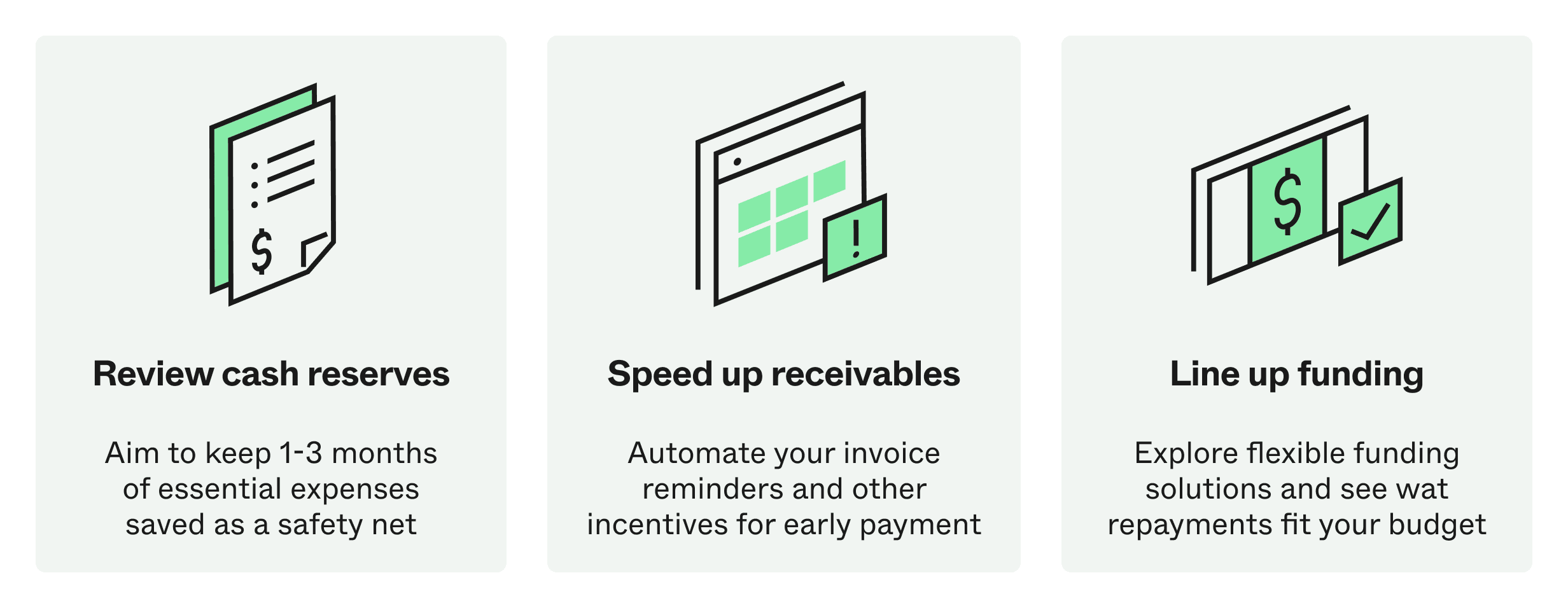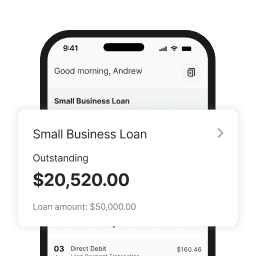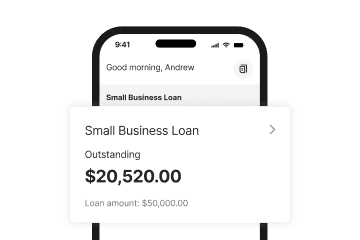Don't let a slow period stop you. Get practical steps to cut unnecessary costs, cover essential bills, and use financial tools to keep your business on track.
At a glance
- Plan ahead for downtime by mapping essential expenses, cutting non-critical costs, and managing business cash flow proactively.
- Use financial tools to forecast gaps, stay on top of payments, and maintain visibility when revenue slows.
- When cash reserves are low, a short-term business loan can help you bridge gaps and cover essential costs.
When business slows down, uncertainty creeps in fast. You have wages to cover, rent and suppliers to pay, but revenue isn’t keeping pace. That pressure can strain even the most organised operator.
You might be wondering: How far will cash reserves stretch? Which costs take priority? And what if the slowdown lasts longer than you expected?
The best thing you can do is tackle downtimes head-on, taking a moment to adjust before pressure builds. This guide will outline the steps you can take to make confident decisions, manage your costs effectively, and move through this period with greater clarity.
Why managing costs during downtime matters
When your business takes a break, your fixed costs don’t. Rent, utilities, insurance, and loan repayments are still due. Without revenue to cover them, these costs eat directly into your cash reserves.
That’s why cost management is critical during slow periods – it puts you back in control and gives your business the breathing room to stay resilient. By preserving cash now, you avoid having to make drastic cuts later, like letting go of valuable staff or selling equipment. So you can be ready to bounce back fast when trade picks up.
Identifying essential vs. non-essential expenses
You want to avoid making tough financial decisions when you’re already under pressure. If you wait until the moment sales dip to review your spending, it’s easy to panic and cut the wrong things.
Better to have your triage plan ready now. Start by clearly separating the costs you must pay to keep the lights on from the “nice-to-haves” you can safely pause. This ensures that if revenue slows, you’re simply executing a strategy, not scrambling for a solution.
Essential expenses
Essential expenses are your non-negotiables – the costs you must pay to keep your business legally and operationally functioning. These are the last to get cut.
The list includes:
- Rent or mortgage payments
- Payroll and super
- Utilities (electricity, water, internet)
- Key suppliers (the ones who provide what you need to make or sell your core product)
- Insurance
- Loan repayments
These are your priority payments. Missing them can damage relationships with your team and suppliers, or grind your operations to a halt.
Non-essential expenses
Non-essential expenses are typically investments in growth, comfort, or morale. They are important, but your business will not collapse if you pause them for a quarter.
This list includes:
- Staff bonuses or travel
- Entertainment and subscriptions (magazines, apps and online services)
- Non-critical software (that tool you only use once a month)
- Office upgrades, new furniture, or equipment that isn’t broken
- Some marketing budgets (the campaigns that are for long-term brand building, not immediate sales)
Cutting or deferring these expenses will protect your cash flow and create some breathing room until revenue picks up again.
Comparing essential and non-essential expenses
| Feature | Essential Expenses | Non-Essential Expenses |
|---|---|---|
| Purpose | Keeps your business operational | Supports comfort, growth, or morale |
| Examples | Payroll & super, rent/mortgage, utilities, key supplier invoices, insurance, and loan repayments | Staff bonuses, travel, entertainment, non-critical software/subscriptions, office upgrades, and some marketing |
| Impacted If Reduced | High: May halt operations, create legal/team issues, or damage supplier trust | Low: Operations continue with minimal impact |
| Action During Downtime | Prioritise payment to maintain stability and trust | Reduce, defer, or pause to free up cash flow |
Practical steps to lower costs
When business slows, the smartest move is to take control early. Here’s how you can lower costs without sacrificing quality or momentum:
Step 1. Go line-by-line on subscriptions. Review your bank statement for all recurring subscriptions, memberships, and software tools. Ask yourself, “Is this tool making me money right now?” Pause or cancel anything that isn’t absolutely essential to your core operation.
Step 2. Talk to your suppliers (and landlord). Reach out before invoices are due. Ask for extended payment terms or a discount for early payment. This also applies to your landlord – it’s always worth asking if any temporary rent relief is possible during a well-communicated quiet period.
Step 3. Optimise your rosters and staffing. Look at your quietest days or hours. Can you adjust rosters to match this reduced demand? This isn’t about cutting team members, but about efficiently matching your labour costs to your incoming revenue.
Step 4. Cut waste from your operational overheads. Don’t just pay your utility bills on autopilot. Check your energy, internet, and phone plans to see if you’re on the best rate. Look at your inventory – tying up cash in excess stock is a common drain. Order less, more often, to protect your cash flow.
Step 5. Automate your cash collection. Time is money, especially when you’re chasing invoices. Use your accounting software to set up automatic invoice reminders. By getting paid faster you can reduce pressure without cutting a single expense.
Leveraging financial tools to pre-empt and bridge gaps
Once you’ve cut costs, the next step is to get full visibility over your cash flow. This is where financial tools come in. Your existing accounting software or Prospa’s free cash flow forecasting template can help you plan, model different scenarios, and – most importantly – see a potential shortfall before it hits.
If your forecast shows a gap, you can then look at financial products to bridge it. A Prospa Small Business Loan, for example, is designed to support your business cash flow. It helps you cover essentials like payroll, rent, or supplier payments, giving you the breathing room to recover and grow once business picks up.
| Case Study |
|---|

When Michael Gallagher of Gallagher Accountants expanded into a new office, he needed extra cash flow to cover rent and bring a valued team member on full time. Rather than turning to a traditional lender, Michael chose a Prospa Small Business Loan to keep his business running smoothly during the move. “Prospa provided me with cash flow when I needed it to keep my business afloat, with a minimum of fuss. They get a feel for your business via your bank statements and make it easy to get funds.” – Michael Gallagher, Gallagher Accountants |
Quick wins to protect your cash flow
Once you’ve taken the steps above, here are three final, high-speed wins you can put into practice today to protect your cash and stay in control.
- Review your cash reserves. Know your exact number. How much cash do you have on hand for emergencies? Aim to have enough to cover one to three months of your essential expenses. This is your safety net.
- Speed up your receivables. Don’t wait for your customers to pay you. Offer small incentives for early payment. More importantly, automate your invoice reminders so you aren’t wasting time chasing money.
- Line up a funding solution. If your forecast shows a cash flow gap, don’t wait until you’re in it to find funding. Explore options like a Prospa Small Business Loan or Line of Credit now. You can use the Prospa Business Loan Calculator to see what repayments fit your budget before you even apply. With funding on standby, you can bridge gaps immediately so you’re never caught off guard.
Quick wins to protect your cash flow:



The peace of mind that comes with a plan
Every business has its ebbs and flows. The truly resilient ones are those who plan for these cycles – they see potential gaps in advance and act before issues arise. As discussed in this article, by identifying essential costs, cutting back on non-essentials, and using financial tools and products, you can pre-empt those gaps and gain the peace of mind you deserve.
And if you need to cover any short-term gap or be ready to take up the next opportunity, talk to one of our specialists today.








